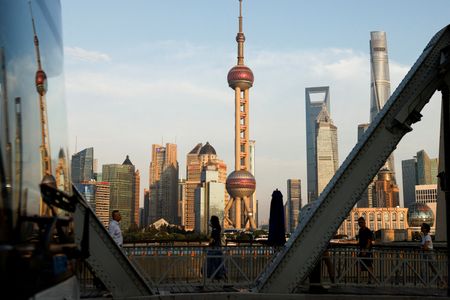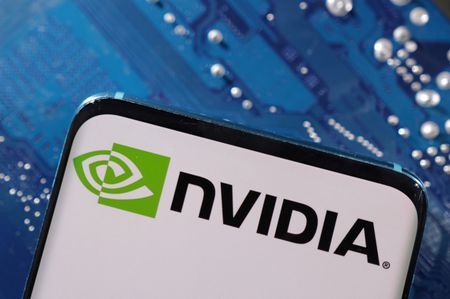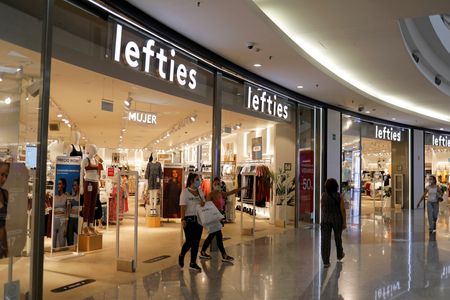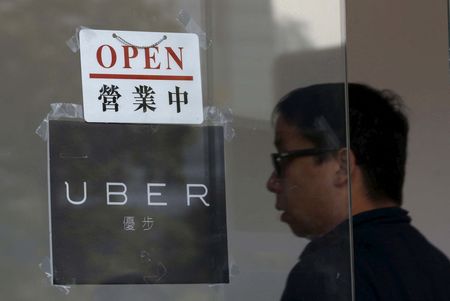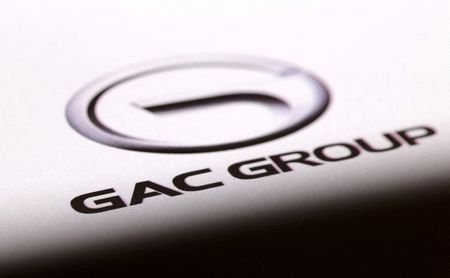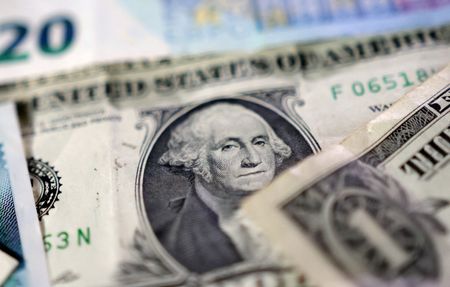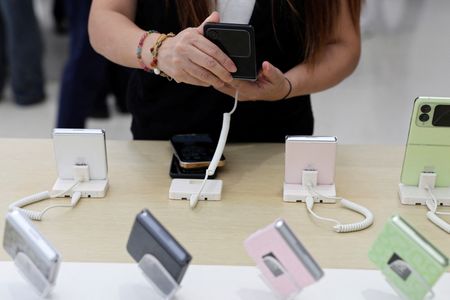(Reuters) – China’s economy grew at a slightly faster pace than expected in the second quarter, showing resilience in the face of U.S. tariffs, though analysts warn of intensifying headwinds that will ramp up pressure on policymakers to roll out more stimulus.
Data on Tuesday showed China’s gross domestic product (GDP) grew 5.2% in the April-June quarter from a year earlier, slowing from 5.4% in the first quarter, but just ahead of analysts’ expectations in a Reuters poll for a rise of 5.1%.
KEY POINTS
* Q2 GDP +5.2% y/y (f’cast +5.1%, Q1 +5.4%)
* Q2 GDP +1.1% q/q (f’cast +0.9%, Q1 +1.2%)
* June industrial output +6.8% y/y (f’cast +5.7%, May +5.8%)
* June retail sales +4.8% y/y (forecast +5.4%, May +6.4%)
* H1 fixed asset investment +2.8% y/y (forecast +3.6%, Jan-May +3.7%)
* H1 property investment -11.2% y/y (Jan-May -10.7%)
MARKET REACTION
China’s blue-chip CSI300 Index reversed course to trade flat, while Hong Kong’s benchmark Hang Seng cut gains after the data came in.
The CSI 300 index was down 0.1%, while the Hang Seng was up 0.7%.
COMMENTARY
BEN BENNETT, HEAD OF INVESTMENT STRATEGY FOR ASIA, L&G ASSET MANAGEMENT, HONG KONG
“Retail sales and investment were lower than expected, but industrial output surprised positively, so policymakers will likely be happy with the overall outcome.
Some investors might be disappointed that this doesn’t signal the need for more immediate stimulus. U.S. tariffs remain a major headwind, but Chinese policymakers won’t feel the need to offset this if economic growth remains strong.”
LISHENG WANG, CHINA ECONOMIST, GOLDMAN SACHS, HONG KONG
“With H1 real GDP growth averaging 5.3% y/y, we do not think policymakers have the urgency to launch broad-based, significant stimulus at the July Politburo meeting.
Instead, we expect incremental, targeted easing to help stem the property downturn and mitigate labour market pressures in H2.”
ALEX LOO, MACRO STRATEGIST, TD SECURITIES, SINGAPORE
“Market reaction was more muted as it was a mixed slate of data… Focus now shifts to the July Politburo meeting which will convene on economic issues.
We expect the discussion to be centred on the property sector after a string of poor housing data and different onshore media leaks that revolved around potential property stimulus.
“We doubt new fiscal stimulus is on the agenda given the remarkable economic growth in H1 and officials will likely prefer to be on a wait-and-see mode and monitor trade developments after the August U.S.-China truce deadline.”
SHANE OLIVER, CHIEF ECONOMIST, AMP, SYDNEY
“Overall, it’s OK, it’s just enough to keep the economy growing around the target pace of 5%.
The economy is growing, but it’s not fantastic, but it’s still growing and I think from a policy point of view, authorities will continue to do just enough to keep it ticking over and will not do more.”
TONY SYCAMORE, ANALYST, IG, SYDNEY
“It’s not a bad number.
I mean it’s a lot better than where we thought things were gonna be back in April, but in terms of retail sales, just a little bit of a miss there. Combined with the CPI number we saw last week and the balance of trade, it’s probably not going to upturn the apple cart too greatly today.
“Probably it looks like the Chinese economy is still muddling through.
And I like the fact that the deflationary spiral last week looks like ended with that better inflation data that we saw.”
CHRISTOPHER WONG, CURRENCY STRATEGIST, OCBC, SINGAPORE
“The Chinese economic and growth data was mixed, with industrial production surprising to the upside despite persistent property sector weakness.
There was only modest impact on the yuan, partly reflecting policymakers’ intent to pursue stability in the yuan. The focus next will be on details of China’s policy support and tariff developments.”
DAN WANG, CHINA DIRECTOR, EURASIA GROUP, SINGAPORE
“Industrial production remains the key growth driver, but it’s highly automated and doesn’t generate jobs.
Q3 growth is at risk without stronger fiscal stimulus. Consumption is weaker than expected — momentum from the trade-in programme has faded, and housing remains a drag with low transaction volumes.
“(U.S.
President Donald) Trump’s tariffs hit exporters hard, triggering SME bankruptcies and damaging sentiment. Both consumers and businesses have turned more cautious, while exporters are increasingly looking overseas for growth.”
JEFF NG, HEAD OF ASIA MACRO STRATEGY, SMBC, SINGAPORE
“The market reaction was quite muted because of the fact that expectations were already there for China to grow by more than 5%.
“Growth has been supported by front-loading… (but) I think we’re still staring at a slowdown once the tariffs come into fruition.
“The domestic economy and retail sales, of course, it’ll still be dragged by concerns.
The sentiment isn’t that great, but at least I see some signs of it bottoming out.”
BACKGROUND
* U.S. President Donald Trump’s global trade war has added a significant new layer of risk for China’s economy, which has been struggling to mount a solid recovery due to a prolonged property crisis, deflationary pressures and low consumer confidence.
* The world’s second-biggest economy has so far avoided a sharp slowdown this year due partly to a fragile U.S.-China trade truce and policy support measures.
* China’s exports regained some momentum in June while imports rebounded, as firms rushed out shipments to capitalise on the tariff truce between Beijing and Washington ahead of a looming August deadline.
* Beijing has ramped up infrastructure spending and consumer subsidies, alongside steady monetary easing. In May, the central bank cut interest rates and injected liquidity as part of broader efforts to cushion the economy from Trump’s trade tariffs.
* But analysts say stimulus alone may not be enough to tackle entrenched deflationary pressures, with producer prices in June falling at their fastest pace in nearly two years.
* China has set an ambitious 2025 growth target of “around 5%”, though the trade war with the United States has already prompted many analysts to sharply downgrade their GDP forecasts for this year.
* For the whole of 2025, China’s GDP growth is forecast to cool to 4.6% – falling short of the official goal – from last year’s 5.0% and ease further to 4.2% in 2026, according to a Reuters poll.
(Reporting by Reuters Asia bureaus; Compiled and edited by Subhranshu Sahu)

